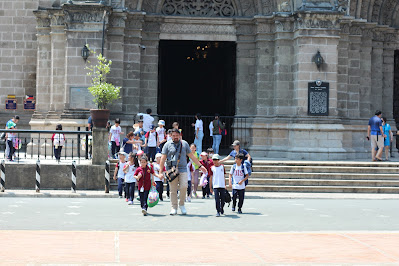The Pasig River Esplanade is an urban development project aimed at revitalizing the area along the Pasig River in Metro Manila, Philippines. It involves creating a scenic, accessible, and sustainable riverside walkway for pedestrians, promoting environmental conservation, and enhancing the aesthetic appeal of the riverbanks. The project includes green spaces, recreational areas, and cultural spots, designed to improve the quality of life for residents and attract tourists. The esplanade is part of broader efforts to rehabilitate the Pasig River, which has suffered from pollution and neglect over the years.
Saturday, June 29, 2024
Monday, June 17, 2024
Laoag Capitol or Ilocos Norte Capitol is a nice place and It's 2024 still looking good and will be looking more amazing in the future!
The capital of Ilocos Norte, a province located in the Ilocos Region of the Philippines, is the city of Laoag. Here are some key points about Laoag:
Laoag City
Historical Background:
- Laoag is one of the oldest settlements in the Philippines, founded by the Spanish in 1580. It became a city on June 19, 1965, under Republic Act No. 4584.
Geographical Location:
- Laoag is situated in the northwest of Luzon Island. It lies along the northern bank of the Laoag River, which provides a scenic backdrop to the city.
Cultural and Historical Sites:
- Saint William’s Cathedral: Known for its sinking bell tower, which sinks into the ground at a rate of about an inch each year due to its heavy weight and soft foundation.
- Museo Ilocos Norte: This museum showcases the rich cultural heritage of Ilocos Norte, including artifacts from the Spanish colonial period, traditional Ilocano crafts, and historical displays.
- Malacañang of the North: Located in nearby Paoay, this presidential museum was the official residence of the Marcos family in Ilocos Norte and offers insights into the history and legacy of former President Ferdinand Marcos.
Economy and Infrastructure:
- Laoag serves as the commercial and industrial hub of Ilocos Norte, with its economy primarily based on agriculture, trade, and tourism.
- Laoag International Airport: The airport connects the city to other parts of the Philippines and international destinations, facilitating travel and commerce.
Tourist Attractions:
- La Paz Sand Dunes: Known for its unique desert environment, it offers activities like sandboarding and 4x4 rides.
- Paoay Church: Officially known as San Agustin Church, this UNESCO World Heritage site is located in the neighboring town of Paoay and is renowned for its distinct architecture.
Festivals and Events:
- Pamulinawen Festival: Held in February, this festival honors Saint William the Hermit, the patron saint of Laoag. It features parades, street dances, cultural shows, and various traditional activities.
- Semana Santa: Holy Week is observed with processions, religious services, and traditional practices, reflecting the deep religious faith of the Ilocanos.
Laoag City serves as a vital center of culture, history, and economic activity in Ilocos Norte, offering visitors a glimpse into the rich heritage and vibrant community of the region.
The San Agustin Church in Intramuros (My first visit)
The San Agustin Church, located in Intramuros, Manila, is one of the most significant and historic landmarks in the Philippines. Here are some key points about the church:
Historical Significance
Oldest Stone Church in the Philippines: The San Agustin Church is the oldest stone church in the country, with its construction completed in 1607. It has withstood numerous natural disasters and historical events, including earthquakes, fires, and wars.
UNESCO World Heritage Site: In 1993, the church, along with three other Baroque churches in the Philippines, was designated as a UNESCO World Heritage Site under the collective title "Baroque Churches of the Philippines." This recognition highlights its architectural and historical importance.
Architectural Style: The church is a fine example of Baroque architecture, characterized by its intricate carvings, detailed facades, and grand interiors. The use of coral stone and its robust structure helped it survive many natural disasters.
Architectural Features
Facade and Bell Tower: The facade of the church is simple yet elegant, with a mix of Baroque and Spanish colonial influences. The bell tower, which was originally twin towers, now stands alone as one of the towers was destroyed during an earthquake.
Interior: The interior of the church is renowned for its trompe-l'œil murals on the ceilings and walls, creating an illusion of three-dimensional architectural features. The church also houses an intricately carved wooden door and a pulpit made from a single block of molave wood.
Retablo: The main altar, or retablo, is a beautiful piece of art adorned with religious icons and detailed carvings.
Historical Events
War and Occupation: During World War II, the church played a significant role as a refuge for civilians during the Battle of Manila. Despite the heavy bombing in Intramuros, the church survived with minimal damage.
Restoration and Preservation: Over the years, the San Agustin Church has undergone several restoration and preservation efforts to maintain its historical and architectural integrity. These efforts ensure that the church remains a vital part of the cultural heritage of the Philippines.
Current Use
- Religious Services: The San Agustin Church continues to serve as a place of worship, hosting regular masses, weddings, and other religious ceremonies.
- Museum: Adjacent to the church is the San Agustin Museum, which houses a collection of religious artifacts, art pieces, and historical items that provide insight into the rich history of the church and the Philippines.
The San Agustin Church stands as a testament to the rich cultural and historical tapestry of the Philippines, embodying the resilience and faith of its people through the centuries.


















